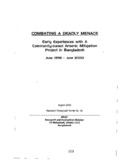| dc.contributor.author | Chowdhury, AMR | |
| dc.contributor.author | Hossain, Md. Zabed | |
| dc.contributor.author | Nickson, Ross | |
| dc.contributor.author | Rahman, Mizanur | |
| dc.contributor.author | Jakariya, Md. | |
| dc.contributor.author | Sharnimuddin, Md. | |
| dc.date.accessioned | 2019-12-19T05:31:18Z | |
| dc.date.available | 2019-12-19T05:31:18Z | |
| dc.date.issued | 2000-08 | |
| dc.identifier.citation | Chowdhury, A., Hossain, M. Z., Nickson, R., Rahman, M., Jakariya, M., & Shamimuddin, M. (2000, August). Combating a deadly menace: early experiences with a community-based arsenic mitigation project in Bangladesh. Research Reports (2000): Social Studies, Vol – XXVI, 259–266. | en_US |
| dc.identifier.uri | http://hdl.handle.net/10361/13319 | |
| dc.description.abstract | Bangladesh is facing the problem of arsenic poisoning in drinking water.
Around 27% of the tubewells, which supply drinking water to most of the
population, have arsenic concentrations above the government of
Bangladesh limit of 50 t.g per litre. This means that a quarter of the •
country's population is exposed to arsenic poisoning which is alarming
and unprecedented in history.
BRAC, a non-governmental organisation, in conjunction with the
Department of Public Health Engineering (DPHE) of the government of
Bangladesh and UNICEF, has implemented a project titled, 'Action
Research into Community-Based Arsenic Mitigation' in two upazilas
of Bangladesh - from June 1999 to June 2000. The aim of the project
was to assess the technical viability as well as the effectiveness of
different alternative safe water options and to figure out the community
acceptance of such options. The activities included the determination of
the extent of arsenic contamination in water of all the tubewells of the
project area; involvement of community members in choosing,
implementing and maintaining alternative sources for safe drinking
water, determination of the viability and effectiveness of different
mitigation option and assess their relative acceptance by villagers;
identification of arsenic-affected patients and providing treatment; and
make the community people aware of arsenic poisoning. This report
presents the experiences of the initial course of project implementation. | en_US |
| dc.language.iso | en | en_US |
| dc.publisher | BRAC Research and Evaluation Division (RED) | en_US |
| dc.subject | Arsenic | en_US |
| dc.subject | Rural community | en_US |
| dc.subject | Drinking water | en_US |
| dc.subject | Arsenic contamination | en_US |
| dc.subject | BRAC | en_US |
| dc.subject.lcsh | Water--Purification--Arsenic removal | |
| dc.subject.lcsh | Arsenic--Toxicology | |
| dc.subject.lcsh | Arsenic--Environmental aspects | |
| dc.subject.lcsh | Groundwater--Pollution | |
| dc.title | Combating a deadly menace: early experiences with a community-based arsenic mitigation project in Bangladesh | en_US |
| dc.type | Research report | en_US |

